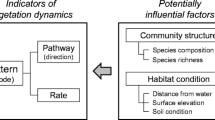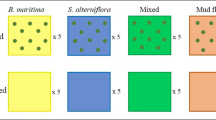Abstract
Water resource development has decreased water delivery to marshes in the Nueces Delta, Corpus Christi, Texas, USA by 45% since 1983, which has led to marsh degradation. Recent management actions will allow for partial hydrological restoration of the marsh, but there is a need to understand the dynamics and the interactive roles of climate and water cycle changes in order to predict changes in salt marshes in the future. In this study, a model of multi-species competition with respect to hydrological change was developed to perform modeling experiments of the effects of water elevation on development of marsh plant species. Nueces Delta plants were divided into two functional groups: (1) clonal stress tolerant plants (Batis maritima, Distichlis spicata, Monanthcloe littoralis, and Salicornia virginica), and (2) clonal dominants (Borrichia frutescens and Spartina alterniflora). Growth rates were calculated for three climate regimes (wet, moderate, and dry), and in three elevation locations (low, mid, and high marsh). The model predicts reductions in plant cover in both drought and moderate conditions. Marsh plant coverage increases only during wet conditions and when there is space available for plant expansion. It is concluded that changes in areal extent of the marsh largely depend on water flow and elevation, which in turn depends on the quantity of fresh water flowing into the marsh. However, under current climate and water management conditions, the marsh will degrade further.






Similar content being viewed by others
References
Adam P (1990) Salt marsh ecology. Cambridge University Press, Cambridge
Alexander HD, Dunton KH (2002) Freshwater inundation effects on emergent vegetation of a hypersaline salt marsh. Estuaries 25:1424–1435
Barajas MJ (2011) Effects of enhancing freshwater inflow on macrofaunal communities in a marsh. Texas A&M University–Corpus Christi, Corpus Christi
Bertness MD, Ellison AM (1987) Determinants of pattern in a New England salt marsh plant community. Ecol Monogr 57:129–147
Bertness MD, Shumway SW (1993) Competition and facilitation in marsh plants. Am Nat 142:71–724
Boutin C, Keddy PA (1993) A functional classification of wetland plants. J Veg Sci 4:560–591
Bureau of Reclamation (BOR) (2000) Concluding report: Rincon Bayou demonstration project Volume II: Findings. Austin, Texas: United States Department of the Interior, Bureau of Reclamation
Chapman VJ (1974) Salt marshes and salt deserts of the world. Cramer, Lehre
Dahl TE, Johnson CE, Frayer WE (1991) Wetlands, status and trends in the conterminous United States mid-1970s to mid-1980s. US Department of the Interior, Fish and Wildlife Service, Washington, DC, p 28
Emery NC, Ewanchuk PJ, Bertness MD (2001) Competition and salt-marsh plant zonation: stress tolerators may be dominant competitors. Ecology 82:2471–2485
Forbes MG, Dunton KH (2006) Response of a subtropical estuarine marsh to local climatic change in the southwestern Gulf of Mexico. Estuar Coasts 29:1242–1254
Gillanders BM (2005) Using elemental chemistry of fish otoliths to determine connectivity between estuarine and coastal habitats. Estuar Coast Shelf Sci 64:47–57
Gillanders BM, Able KW, Brown JA, Eggleston DB, Sheridan PF (2003) Evidence of connectivity between juvenile and adult habitats for mobile marine fauna: and important component of nurseries. Mar Ecol Prog Ser 247:281–295
Grime JP (1979) Evidence for the existence of three primary strategies in plants and its relevance to ecological and evolutionary theory. Am Nat 111:1169–1178
Herzka SZ (2005) Assessing connectivity of estuarine fishes based on stable isotope ratio analysis. Estuar Coastal Shelf Sci 64:8–69
Hill EM, Tunnell JW, Lloyd L (2012) Spatial effects of Rincon Bayou pipeline freshwater inflows on salinity in the lower Nueces Delta, Texas. Final report to the coastal bend bays & estuaries program, CBBEP publication 81, project number 1202, Corpus Christi, TX http://cbbep.org/publications/publication1202.pdf
Irlbeck MJ, Ward GH (2000) Analysis of the historic flow regime of the Nueces river into the upper Nueces Delta, and of the potential restoration value of the Rincon Bayou demonstration project, Volume II, Appendix B. In bureau of reclamation, concluding report: Rincon Bayou demonstration project. Austin, TX: U.S. Department of the Interior, Bureau of Reclamation. https://archive.org/stream/rinconbayoudemon00unit/rinconbayoudemon00unit_djvu.txt
Martinez-Martinez E, Nejadhashemi AP, Woznicki SA, Love BJ (2014) Modeling the hydrological significance of wetland restoration scenarios. J Environ Manag 133:121–134
Montagna PA, Alber M, Doering P, Connor MS (2002a) Freshwater inflow: science, policy, management. Estuaries 25:1243–1245
Montagna PA, Kalke RD, Ritter C (2002b) Effect of restored freshwater inflow on macrofauna and meiofauna in upper Rincon Bayou, Texas, USA. Estuaries 25:1436–1447
Montagna PA, Gibeaut JC, Tunnell JW Jr (2007) South Texas climate 2100: Coastal impacts. In: Norwine J, John K (eds) South Texas climate 2100: problems and prospects, impacts and implications. CREST-RESSACA. Texas A&M University-Kingsville, Kingsville, Texas. Chapter 3, pp 57–77
Montagna PA, Hill EM, Moulton B (2009a) Role of science-based and adaptive management in allocating environmental flows to the Nueces Estuary, Texas, USA. In: Brebbia CA, Tiezzi E (eds) Ecosystems and sustainable development VII. WIT Press, Southampton, pp 559–570
Montagna PA, Palmer T, Gil M, Hill E, Nicolau B, Dunton K (2009b) Response of the Nueces estuarine marsh system to freshwater inflow: an integrative data synthesis of baseline conditions for faunal communities. Final report to the coastal bend bays & estuaries program, CBBEP publication 27, project number 0821, Corpus Christi, TX. http://cbbep.org/publications/virtuallibrary/0821.pdf
Montagna PA, Brenner J, Gibeaut J, Morehead S (2011) Coastal Impacts. In: Schmandt J, North GR, Clarkson J (eds) The impact of global warming on Texas, 2nd edn. University of Texas Press, Austin, pp 96–123
Montagna PA, Nelson K, Uppaluri A (2012) Water and sediment quality status and trends in the coastal bend area—Phase 1: data archiving and publishing. Final report to the coastal bend bays & estuaries program, CBBEP publication 77, project number 1105, Corpus Christi, TX. http://cbbep.org/publications/virtuallibrary/1105.pdf
Palmer TA, Montagna PA, Kalke RD (2002) Downstream effects of restored freshwater inflow to Rincon Bayou, Nueces Delta, Texas, USA. Estuaries 25:1448–1456
Raffaelli D, Hawkins S (1996) Intertidal ecology. Chapman and Hall, London
Rasser MK (2009) The role of biotic and abiotic processes in the zonation of salt marsh plants in the Nueces river Delta, Texas. Ph.D., University of Texas Austin. https://repositories.lib.utexas.edu/bitstream/handle/2152/6870/rasserm56065.pdf
Rasser MK, Fowler NL, Dunton KH (2013) Elevation and plant community distribution in a microtidal salt marsh of the Western Gulf of Mexico. Wetlands 33:575–583
Riera P, Richard P, Grémare A, Blanchard G (1996) Food source of intertidal nematodes of the Bay of Marennes-Oléron (France), as determined by dual stable isotope analysis. Mar Ecol Prog Ser 142:303–309
Riera P, Montagna PA, Kalke RD, Richard P (2000) Utilization of estuarine organic matter during growth and migration by juvenile brown shrimp Penaeus aztecus in a South Texas estuary. Mar Ecol Prog Ser 199:205–216
Ryan AJ, Hodges BR (2011) Modeling hydrodynamic Fluxes in the Nueces river Delta. Final report to the coastal bend bays and estuaries program, CBBEP publication 75, project number 1001, Corpus Christi, TX. http://cbbep.org/publications/virtuallibrary/75.pdf
Sadovski A, Montagna PA (2010) Spatial-temporal model of multi-species vegetation in marshlands. In: Andrea P, Kilyeni S (eds) Selected topics in mathemathical methods and computational techniques in electrical engineering, WSEAS Press, pp 161–164
Secor H, Rooker JR (2005) Connectivity in the life histories of fishes that use estuaries. Estuar Coast Shelf Sci 64:1–3
Stachelek J, Dunton KH (2013) Freshwater inflow requirements for the Nueces Delta, Texas: Spartina alterniflora as an indicator of ecosystem condition. Tex Water J 4:62–73
Tunnell JW, Lloyd L (2011) Effects of Rincon Bayou pipeline inflows on salinity structure within the Nueces Delta, Texas. Final report to the coastal bend bays and estuaries program, CBBEP publication 76, project number 1106, Corpus Christi, TX. http://cbbep.org/publications/virtuallibrary/1106.pdf
Twilley R, Barron EJ, Gholz HL, Harwell MA, Miller RL, Reed DJ, Rose JB, Siemann EH, Wetzel RG, Zimmerman RJ (2001) The report: confronting climate change in the gulf coast region: prospects for sustaining our ecological heritage. Washington, DC
Vasconcelos RP, Reis-Santos P, Maia A, Fonseca V, Franca S, Wouters N, Costa MJ, Cabral HN (2010) Nursery use patterns of commercially important marine fish species in estuarine systems along the Portuguese coast. Estuar Coastal Shelf Sci 86:613–624
Ward GH Jr, Irlbeck MJ, Montagna PA (2002) Experimental river diversion for marsh enhancement. Estuaries 25:1416–1425
Zedler JB, Callaway JC, Desmond JS, Vivian-Smith G, Williams GD, Sullivan G, Brewster AE, Bradshaw BK (1999) California salt marsh vegetation: an improved model of spatial pattern. Ecosystems 2:19–25
Zirnmerman RJ, Minello TJ, Zamora G (1984) Selection of vegetated habitat by brown shrimp, Penaeus aztecus, in a Galveston Bay salt marsh. Fish Bull 82:325–336
Acknowledgements
Many people provided help during this study as it evolved to its current state. A key insight was provided by Michael Rasser (then a doctoral student at The University of Texas Marine Science Institute and now at the Bureau of Ocean Energy Management) who demonstrated the link between elevation and plant distribution. The marsh digital elevation model, which was critical for implementing our diffusion model, was supplied by Dr. James Gibeaut of the Harte Research Institute. Evan Turner, then a TAMUCC doctoral student, provided useful suggestions and insights as the model was being developed. This work is funded principally by the United States Army Corps of Engineers under contract W9126G-09-T0076, where Marcia Hackett is the project manager. However, additional support was provided by the TAMUCC Texas Research Development Fund, and the Harte Research Institute for Gulf of Mexico Studies. Additional funding by the Coastal Bend Bays & Estuaries Program was used to create the databases that are used in this study.
Author information
Authors and Affiliations
Corresponding author
Rights and permissions
About this article
Cite this article
Montagna, P.A., Sadovski, A.L., King, S.A. et al. Modeling the effect of water level on the Nueces Delta marsh community. Wetlands Ecol Manage 25, 731–742 (2017). https://doi.org/10.1007/s11273-017-9547-x
Received:
Accepted:
Published:
Issue Date:
DOI: https://doi.org/10.1007/s11273-017-9547-x




